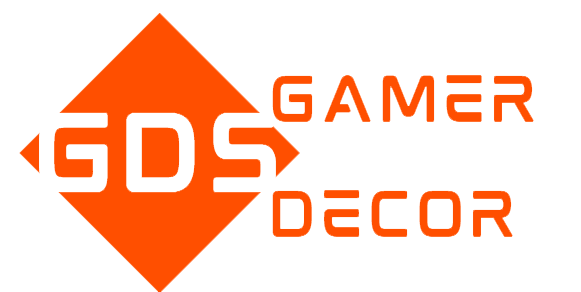If your desk feels cramped or your monitor never sits quite right, the quickest upgrade is how you mount it. Two options dominate: monitor arms and monitor stands. Both improve ergonomics and style, but in different ways. This guide breaks down what each does best so you can pick the one that opens space and elevates your setup.
Found This Guide Useful?
We ship internationally and we’re here to help you find exactly what you need for your perfect gaming space.
Visit Our ShopWhat a Monitor Arm Does (and why people love it)
A monitor arm clamps to the desk (or goes through a grommet) and lets your screen “float” above the surface.
Highlights
- True flexibility: Raise, lower, swivel, tilt, pull forward, push back, rotate to portrait.
- Space gains: Clears the area under your display for speakers, notebooks, or a clean empty surface.
- Better posture: Align the top of your screen at or slightly below eye level and sit back—less neck strain.
- Modern look: A floating panel instantly makes the setup feel premium and minimal.
Best for: Minimalist desks, dual/triple displays, streamers who re-position often, low-DPI gamers who need exact height/angle.
What a Monitor Stand Does (and why it still works)
A stand sits on your desk and raises the monitor to a comfortable height—no tools, no mounting.
Highlights
- Zero install: Unbox, place, done.
- Extra storage: Many stands add shelves/drawers; stash controllers, docks, or notepads underneath.
- Style options: Wood, bamboo, glass, acrylic—easy to match cozy or natural aesthetics.
- Universal fit: Works with almost any monitor (no VESA required).
Best for: Cozy/wood-forward rooms, renters who can’t clamp mounts, anyone who wants fast improvement with no fuss.
Quick Compare
| Feature | Monitor Arm | Monitor Stand |
|---|---|---|
| Space under screen | Clears entire area | Partial shelf space |
| Adjustability | Excellent (height, depth, tilt, swivel, rotate) | Limited (fixed height/angle) |
| Install effort | Medium (clamp/grommet) | Very low |
| Aesthetic vibe | Modern, minimal, “floating” | Cozy, furniture-like |
| Multi-monitor | Great (dual/triple arms) | Okay (wide stands) |
| Cable management | Built-in channels on many arms | Depends on stand design |
| Price range | Mid → high (quality matters) | Low → mid |
Ergonomics: the settings that actually help
Whichever route you choose, aim for:
- Top of screen at or slightly below eye level
- About an arm’s length distance from your face
- Neutral tilt (slight downward tilt is fine)
- Chair and desk height adjusted so shoulders relax and wrists stay straight
A monitor arm makes this easy because you can fine-tune daily. A stand works if your seating posture is consistent and you don’t need frequent changes.
Space & Style: opening the desk vs adding character
- Monitor arm: Maximum open space, clean lines, minimal visual weight. Perfect with RGB underglow, slim speakers, and a large mouse mat.
- Monitor stand: Adds warmth and layers—especially in rooms with textured walls, plants, and table lamps. The shelf can stage accessories (headset stand, small plants) without clutter.
Choose the one that fits your brand of “clean”:
- Tech-minimal → arm
- Cozy-natural → stand
Build quality: what to look for before you buy
For Monitor Arms
- Weight rating & VESA (75×75 or 100×100) must match your monitor. Check ultrawide support.
- Gas spring vs friction: Gas springs allow effortless height changes; quality costs more but feels better.
- Clamp depth: Ensure your desk edge is thick/solid enough for the clamp or use a grommet.
- Cable channels: Keeps power/HDMI/DP tidy.
For Monitor Stands
- Material & stability: Solid wood/bamboo or metal frames resist wobble.
- Height gain: 3–4 inches is typical; verify it lifts enough for eye level.
- Shelf clearance: Make sure your keyboard, dock, or notebook fits beneath.
Dual and ultrawide setups
- Dual monitors: A dual arm lets you angle screens in a slight V and match heights perfectly. Great for gaming + chat/stream tools.
- Ultrawide: Check arm capacity (weight and width). Quality arms handle 34–38″ panels; budget arms may sag.
- Stand route: Use a wide stand or two matching stands to level mismatched displays—simple and symmetrical.
Cable management that finishes the look
No matter the mount:
- Route power and video along the arm or behind the stand.
- Use low-profile Velcro ties and adhesive clips under the desk.
- Leave slack where the arm moves; keep the rest invisible.
Clean cables = premium setup.
Which should you choose?
Choose a Monitor Arm if you:
- Want maximum desk space and a floating aesthetic
- Adjust height/angle often or switch seating positions
- Run dual/ultrawide and care about perfect alignment
Choose a Monitor Stand if you:
- Prefer plug-and-play and cozy, furniture-style setups
- Want a shelf for storage/display
- Can’t clamp or drill your desk
Hybrid option: Use an arm for the main screen and a low stand for a secondary display, console monitor, or laptop.
Setup checklist (copy/paste)
- Confirm VESA pattern and weight support
- Measure desk overhang for clamp or grommet location
- Plan cable routes and tie points before mounting
- Set eye-level height, arm’s-length distance, slight downward tilt
- Tweak for glare and match lighting style (bias light behind monitor looks great with both)


